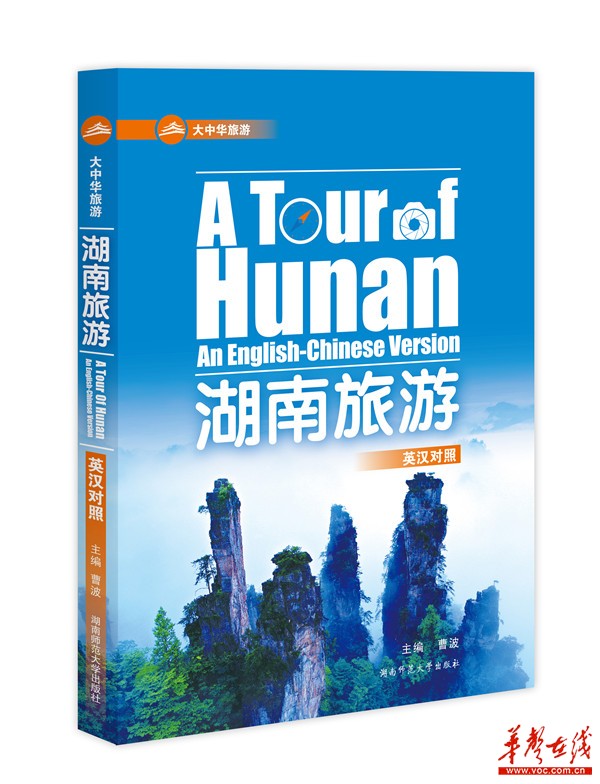
(第一章 第二节“历史源流”,原书第6—9页)
1.2 History
Hunan boasts a long history. As early as 8,000 years ago, primitive tribes began to multiply here. Legend has it that Emperor Yan, an ancestor of the Chinese nation, lived here and greatly promoted ancient agriculture. To commemorate the Chinese Saturn, a grand mausoleum has been built in Ling County, where he was said to be buried about 5,000 years ago.
In the Spring and Autumn Period (770 BC—476 BC), Hunan became part of the ducal state of Chu, and the unique Chu Culture evolved gradually as a result of the combination of the aboriginal civilization with the culture of Central China. Among the relics excavated from the tombs of that period in Changsha, the steel sword, the writing brush, and the paintings on silk are all the earliest of their kinds ever found in China.
In the Warring States Period (475 BC—221 BC), Qu Yuan, a patriotic minister of Chu, was banished to the Yuan River of Hunan, where he produced such monumental collections of poems as Nine Odes and Questions to Heaven. Depressed by the subjugation of his mother-land by the state of Qin, he drowned himself in the Miluo River in 278 BC, leaving later generations in eternal memory of him.
In 221 BC, Ying Zheng, the king of Qin, unified China and became the First Emperor of the Qin dynasty. He ordered the construction of a 45-km-long road to connect Chenzhou with Yizhang in South Hunan and the dredging of the 30-km-long Ling Canal to link the Xiang River to the Li River in Guangxi. These measures remarkably furthered the development of Hunan’s economy and culture.
Soon after the founding of the Han dynasty in 206 BC, the State of Changsha was established within the boundaries of today’s Hunan. It witnessed Hunan’s great advances in science. Cai Lun (61—121), a native of Leiyang in South Hunan, ingeniously improved paper-making techniques and succeeded in producing the world’s first sheet of paper of various plant fibers, which is considered one of the four great inventions of ancient China. The 3,000-odd invaluable funeral objects excavated from the Han Tombs at Mawangdui, Changsha, forcibly indicate the high level of Hunan’s civilization over 2,000 years ago.
When China was split into the three kingdoms of Wei, Shu and Wu in 220 AD, the Xiang River served as a boundary between Shu and Wu and, therefore, Hunan became a place of strategic importance that the 3 kingdoms would contend dozens of years for. It was in the borderland between Hunan, Hubei and Jiangxi that the decisive Red Cliff Campaign took place.
In 764 AD, the Tang dynasty (618—907) authorities appointed an Imperial Inspector to Hunan. Since then the name “Hunan” has been in use throughout all the later dynasties. The following millennium witnessed Hunan’s great strides in economy, politics and communication. An ancient popular saying goes, “A harvest in Hunan and Hubei is one enough for the world.”
In the Song dynasty (960—1279), porcelain from Tongguan Kilns of Changsha began to sell well in Southeast Asia and Arab countries. Tea from the Junshan Isle, Yueyang, and tung oil from South Hunan and West Hunan also became popular throughout the country.
Of the four great academies of higher learning set up in the Song dynasty, two were in Hunan, namely, Yuelu Academy (976—) in Changsha and Shigu (Stone Drum) Academy in Hengyang. In the Ming dynasty (1368—1644) and the Qing dynasty (1616—1911), they developed steadily and gave birth to a multitude of eminent scholars and statesmen, among whom, to name only a few, are Zhou Dunyi (1017—1073, a pioneering idealist philosopher), Wang Fuzhi (1619—1692, an outstanding Neoconfucianist thinker) and Li Dongyang (1447—1516, Minister of Rites of the Ming court).
The Opium War in 1840, or the Trade War between China and Britain, matured many pioneering thinkers. Wei Yuan (1794—1857), a native of Hunan, compiled his inspiring book Illustrated Notes on Overseas Countries and uttered his striking slogan “learn from western countries to match them”. The Hunanese people were also the first to respond to the 1911 Revolution, which ultimately toppled the Qing dynasty. General Huang Xing, a native of Changsha, was appointed Commander-in-Chief of the army of Sun Yatsen’s provisional government in Nanjing. In 1915, General Cai E (1882—1916), a native of Shaoyang, raised the Republic-Protecting Army and overturned Yuan Shikai’s monarchy.
Hunan has also been a cradle of revolutions led by the Communist Party since the May 4th Movement in 1919. It is in Hunan that Chinese workers and peasants’ movements in the 1920’s developed most vigorously. The troops of the Autumn Harvest Uprising withdrew from Hunan and established a base for the national revolution in the Jinggang Mountains, a range in the border region between Jiangxi and Hunan. Eventually in August, 1949, Hunan was peacefully liberated. As the birthplace of Mao Zedong and many other founders of New China, Hunan has been a land of miracles that many look forward to visiting.
第二节 历史源流
湖南历史悠久,早在8,000多年前就有原始部落繁衍生息。传说5,000年前,中华民族的始祖之一炎帝曾在此生活,极大发展了原始农业。为纪念这位神农氏,人们在他“崩葬”的酃县建造了规模宏大的陵墓。
春秋时期(公元前770年—公元前476年),湖南隶属楚国,原有土著文化与中原文化逐渐融合,形成了独特的楚文化。长沙楚墓出土的钢剑、毛笔和帛画等均为中国最早的珍品。
战国时期(公元前475年—公元前221年),楚国大夫屈原被流放湖南,写下了《九歌》、《天问》等不朽的诗篇。闻知祖国终被强秦所灭,屈原悲愤欲绝,于公元前278年自沉于汨罗江,令后人叹惋不已。
公元前221年,秦王嬴政统一中国,称秦始皇。他下令在湖南南部修建45公里驰道,连通郴州至宜章,又在与广西交界处开凿30公里灵渠,以沟通湘江和广西的漓江。这些措施大大推动了湖南经济和文化的发展。
公元前206年,汉朝建立之初就在今湖南境内设长沙国,从此湖南的科技飞速发展。湘南耒阳人蔡伦生产出世界上第一张植物纤维纸,其造纸术为中国古代四大发明之一。长沙马王堆汉墓出土了3,000余件殉葬品,有力地证明两千多年前的湖湘文明达到了相当高的水准。
公元220年,中国分裂为魏、蜀、吴三国,湘江是吴蜀边界,因而湖南就成了数十年间三国必争之地。决定性的赤壁之战就发生在湖南、湖北和江西三省的边界。
公元764年,唐王朝设置“湖南观察使”,此后各朝各代均沿袭“湖南”之名。随后一千余年间,湖南在经济、政治和交通等方面都取得较大发展。古谚云:“湖广熟,天下足。”
宋代时,湖南铜官窑生产的瓷器开始远销东南亚和阿拉伯各国;岳阳君山的茶叶及湘南与湘西的桐油也畅销全国。
宋代四大书院中,湖南居其二,即长沙的岳麓书院和衡阳的石鼓书院。明、清时期,两书院蓬勃发展,诞生了一大批赫赫有名的学者和政治家,宋代理学始祖周敦颐、明代礼部尚书李东阳、清初杰出思想家王夫之即是其中的代表。
1840年的鸦片战争教育了中国早期的近代思想家。湖南人魏源编撰了启蒙之作《海国图志》,发出令人警醒的呼声“师夷长技以制夷”。1911年辛亥革命爆发,湖南率先响应,最终推翻了满清王朝。黄兴将军时任孙中山领导的南京临时政府陆军总长。1915年,蔡锷将军率护国军推翻了袁世凯的独裁统治。
1919年五四运动以来,湖南一直是中国共产党领导的新民主主义革命的摇篮。她是20世纪20年代工农运动浪潮最汹涌的省份,秋收起义的部队就是从湖南撤退,在湖南、江西边界的井冈山建立了全国革命的根据地。1949年8月,湖南终于和平解放。作为毛泽东和许多其他新中国缔造者的故乡,湖南是无数人向往的圣地。